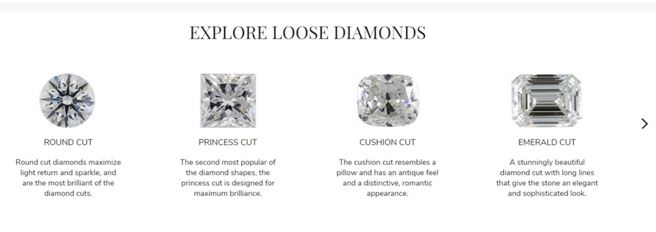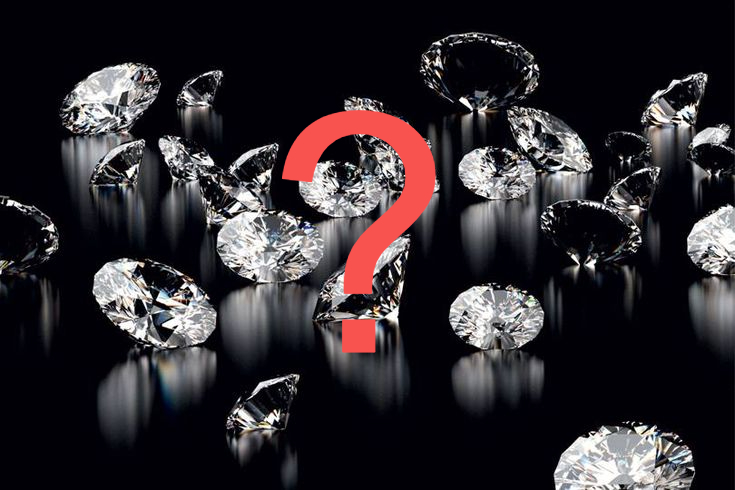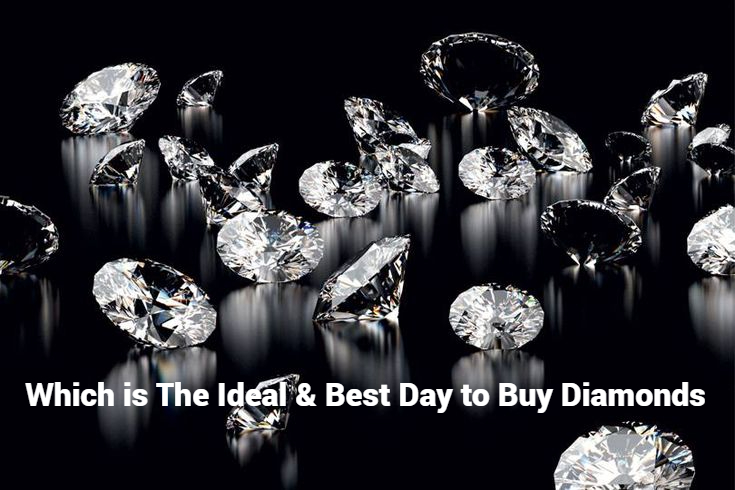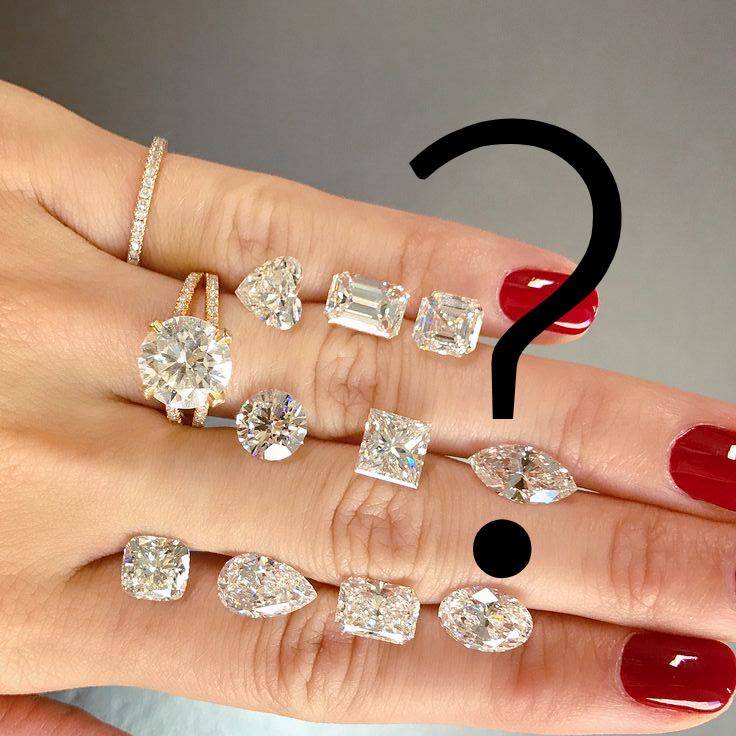Radiant cut diamond is considered to be one of the most brilliant diamond shapes with a shimmering 70 facets cut. The Radiant cut diamond combines features of three most popular diamond shapes which give it an edge over its competition. It possesses the clipped corners of the wonderful Asscher cut, the openness of the Emerald cut and the fire and elegance of the Round cut. This unequaled incarnation of different traits appeals to any individual looking for a modern fusion look. It’s completely brilliant-cut facet pattern is applied to its crown and pavilion which gives it a vibrant and exuberant look.
The radiant cut diamond owes its brilliance to carefully beveled corners which offers it immense brilliance and fire. The 70 facets in a Radiant cut diamond allow it to emanate a tremendous amount of shine which anyone would fall in love with. It’s only been 39 years since the radiant cut diamond has been introduced to the diamond community and yet it has managed to gain such widespread popularity in this short amount of time. Only the Round Brilliant has been found to outshine the radiant cut in terms of brilliance. Radiant is known to have well-refined durability which makes it insusceptible to chips and breakage. Thus, it is an excellent choice for those with a very active lifestyle. Also, the Radiant cut diamond is a brilliant reflector of light and for this reason, it is presented as an alternative to the Emerald cut diamond after its invention.
Interesting information about the Radiant cut diamond is that from a bureaucratic point of view, it does not exist and it is shocking but actually true. The technicalities behind the diamond explain it. Also, the Gemological Institute of America (GIA) does not refer to these diamonds as ‘radiant cuts’. Rather, they call it a “cut-corner rectangular modified brilliant” or “a cut corner square modified brilliant” which is, however, depending on the diamond’s outline. What this terminology is driving at is that a Radiant cut diamond is in all likeliness a Princess cut diamond with its corners off. However, you can identify between a Princess cut and a Radiant cut by the real differences which lies on the internal facet structures and the 4 truncated corners. When it comes to optical strength and capability, the Princess cut comes with a much better linear character in the form with which it easily reflects light. In terms of optical performance, the princess cut has a much more linear character in the way it reflects light. And on the other hand, the radiant cut diamond presents a series of concentric circles radiating from the center. These radiating concentric rings gave birth to the diamonds’ trade names. However, the Radiant cut diamond comes in two different shapes which are the square-shaped Radiant and the Rectangular shaped Radiant. For Square-shaped Radiant, it is common to see their ratios fall within 1.00-1.5 and if this ratio reaches from 1.05 to as high as 1.50, it shows a direct indication of a rectangular radiant. Because it happens to be a patented cut, it can be safely expressed as Cut-Cornered that is, AGS or GIA. If it comes with a ratio which is above 1.05, it can be regarded as Rectangular Brilliant.
Henry Grossbard wanted to create a diamond cut that would unleash the full potential of a diamond’s brilliance after working for thirty years as a master diamond cutter. A cross-cutting style was developed by him which of course changed the way the industry sees square-shaped or rectangular stones. He did develop a step-cut diamond that has an almost strength of brilliance such as that found in triangular-faceted diamonds.
Having the intention to develop a superior cut of such uniqueness from a synergistic effect of the most quality round brilliant cut and the emerald cut, the diamond cut was invented by Henry Grossbard in 1977. Although the most notable shape of most Radiant diamond cuts stands to be the rectangular emerald-like shape, it is not unlikely to see a collection of radiant cut diamonds coming in the shape of a square. However, there are clear cut distinctions between these two shapely-different types. This distinction is evident in the many facets and substantial vivacity which the radiant cut diamond comes with which is significantly higher than that of the rectangular emerald-like shape types. The radiant diamond cut is widely known within popular faces, thanks to its indisputable attractiveness. The prime Radiant Cut Diamond brand was first inaugurated in 2002 by the Radiant Cut Diamond Company. In 1400, the table cut was most prominent, in 1700, the Peruzzi cut dominated. The Round Brilliant cut came around in the year 1919 and the Modern Radiant was invented in 1977. These were the prominent diamond cuts in their timeframe
The Radiant cut diamond is known to share certain similarities with the Cushion Cut diamonds; however, they have different characteristics especially in regard to their appearances. Radiant cut diamonds carry distinct edges while Cushion cuts come with increased rounded edges but it is expressly true that both exhibit neatly carved corners which add to their stability. The cushion is widely recognized for its unalloyed fire as well as the brilliance it offers. However, the large table and numerous facets of the Radiant give it with unmatched brilliance.
You will easily find Radiant cut diamonds and Cushion cut diamonds in ranging collections of rectangular and square constitutions although length to width ratios is dependent on the taste of individuals, that is, personal preference. Picking one of these two over the other totally depends on the personal preference of the individual interested in purchasing them as the Cushion and Radiant cuts are both unique and distinct shapes.
Cut very important especially to the final beauty of any Radiant diamond and as a result of this, it is essential to exercise thorough examination of these stones when about to make a purchase. The brilliance of Radiant cut diamonds can be traced to the development of the diamond which has an adapted cut facet archetype for the crown as well as the pavilion. It is important to take a careful look at Radiant diamonds perhaps when making a buying decision and the help of an expert will definitely come in handy.
There are guidelines as well as outlined proportions for selecting a radiant diamond’s cut.
Be sure to look at the corners of a Radiant in order to ensure they are even and not too wide or too narrow. What gives a radiant its stunning look is its well-shaped corners which leads to its firmness and solidity. However, it must stay equally proportioned in symmetry so as to keep its overall beauty.

About Radiant Cut Diamond
Choosing a Radiant diamond’s cut, the listings go as such;
As regards Depth, a poor depth percentage falls within 52 to 80% and a good one can be found around 57 to 59% or 71 to 74.5%. It is considered very good if the depth percentage falls within 58.8 to 70% or 67 to 70.1% and a radiant diamond cut’s depth percentage can be considered excellent if it is within 61.3 to 67%
For table percentage, a radiant cut is considered poor or relatively fair, good, very good, or excellent if it falls within less than 50 to 80%, 53-57 or 74%, 58 to 61% or 71%, or 62 to 70% respectively.
The Culet is considered poor or fair if it is very large, good if it is medium, very good if is very small or negligible, and excellent if there isn’t any at all.
As per the girdle, it is poor of fair within the extreme thickness and extreme thinness, good if within very thin and thick, very good if within very thin and slightly thick, and excellent if within very thin and slightly thick.
For length to width ratio, it is considered poor, good, very good, or excellent if it falls within greater than 1.09/1.07 to 1.09, 1.05 to 1.06, 1.05 to 1.06, 1.00 to 1.04, or 1.00 to 1.04 respectively for a square cut. However, it is the same if these parameters fall within less than 1.08 or greater than 1.41/1.007 to 1.08, 1.09 to 1.13/1.37 to 1.41, 1.14 to 1.20/ 1.32-1.36, or 1.20 to 1.31 respectively for rectangular cuts.
The detailed information above gives a useful probe into the things to consider when examining a radiant diamond’s cut. Although choices and individual inclinations may differ, the most ideal length to breadth dimension when it comes to achieving the right cut for a squared radiant cut diamond or even a rectangular shaped is within 1.00 to 1.04 or 1,20 to 1.31. If you are the type that is keen on the enchanting nature and elegance of emerald diamond as well as a round diamond, you should go for radiant cut diamond. This, of course, will stand to be a flawless blend of a curved diamond when it comes to fire and impairments. With a cushion and princess cut, you can be sure to also achieve a flawless mix considering its well carved square shape.
LENGTH TO WIDTH RATIO
The length to width ratio of a diamond is indicative of how balanced the diamond has been carved out in relation to the dimension of its desired shape, that is, rectangular vs square. Just like we know from experience, personal taste plays a huge role in determining how you will love your diamond; your desired ration for your diamond depends on what really suits your taste. Conventionally, the range of length to width ratio usually falls within 1.00 – 1.35 which makes the end below to look significantly squarer in shape. However, you can have the length to width ratio increased to 2.0 especially if you are willing to have your diamond to appear more rectangular in shape.
For Square
- Excellent: 1.00 to 1.03
- Very good: 1.00 to 1.03
- Good: 1.04 to 1.05
- Fair: 1.06 to 1.08 or 1.08
- Poor: less than 1.08
For Rectangle
- Excellent: 1.20 to 1.30
- Very good: 1.15 to 1.19 or 1.31 to 1.35
- Good: 1.10 to 1.14 or 1.36 to 1.40
- Fair: 1.08 to 1.09 or 1.41 to 1.50
- Poor: less than 1.08 or greater than 1.50
It is advisable that you go through a number of different lengths to width ratios to provide you sufficient information to determine what best fit is for you before making your final decision.

Radiant Diamond Clarity
This just describes how flawless and perfect a diamond is which of course a measure of its blemishes and inclusions is. Simply put, clarity describes how clean a diamond is. According to GIA, clarity ranks are expressed in the following parameters:
- I3 – Inclusion 3
- I2 – Inclusions
- I1 – Inclusions
- SI2 – Slightly Included
- SI1 – Slightly Included/Small Inclusions
- VS2 – Very Slightly Included/Very Small inclusions
- VS1 – Very Slightly Included/Very Small Inclusions
- VVS2 – Very Very Slightly Included/Very Very small inclusions
- VVS1 – Very Very Slightly Included/Very Very small inclusions
- IF – Internally Flawless/Clean no inclusions internally
- Flawless – perfect in all angles
For two adjacent grades, the difference that exists in between their appearance is usually indistinguishable by the ordinary eye.
Also, Radiants are carved with a number of angles and varying faces which ultimately gives them such squashed ice look. As a result, this feature only tends to enhance the ability of blemishes and inclusions to stay hidden. Impliedly, because of the many facets and angles that come with radiant cut diamonds, it gets more difficult to have a straight clue of its flawlessness and excesses as they are usually out of sight. Thus, it happens as the best option that you purchase radiant cut diamonds with such of precision of either S2 or S1 so as to curtail any possibility of purchasing a flawed radiant cut diamond or one with no great shakes.
However, it is advisable to have the help of an expert guide you through your purchase of radiant cut diamond so you can easily take cognizance of excesses and blemishes.

Evaluating Radiant Diamond Color
Based on experience and past buyers’ purchase behaviors, it has been observed that most buyers have a stronger tendency to pick warmer colors instead of the other colorless grades out there especially that the cost of diamond varies from grade to grade and place to place. Taking a look at the color scheme, warmer colors are found close to the colorless region of G-I color diamonds and at region D-F, you can find the colorless colors. Nevertheless, the radiant cut diamonds of lower color grades are expected to be found in the market at affordable and reduced rates.
Based on GIA calibration and grading, color rankings differ from D to Z. You will find diamonds in the D grade to be exquisitely clear, crisp and colorless while that of the Z grade indicates diamonds with characteristic brown shades and conspicuous yellow. In Radiant cuts, the color variation that exists in the is somewhat seamless to notice than other it is in other diamond cuts. Yet, we do advise the H color as the diamond will look white and somewhat colorless to the ordinary eye. Although, we will recommend you cut down expenses to preserve your budget for other important aspects including cut quality which is vital. Also, ensure that your diamond comes in a clean white appearance as alignment to its setting which actually depends on the choice set which also determines your tractability with color choice.

Radiant Diamond Carat Weight
Here are some recommendations on suggested carat weight:
An excellent radiant cut diamond will have its weight to be at a minimum of 1.0 carats, superior polish and symmetry, SII or more in clarity, be above or exactly G on the color spectrum and will have no florescence. You can find such in the length/width ratio within 1.0 to 1.04 and 1.2 to 1.35 for square shaped and rectangular shaped respectively.
Similarly, for very good choice, the weight will be at a minimum of 0.90 carats and exhibit a good polishing and symmetry, be exactly on H or around it in terms of color, SIIor beyond in regard to quality, absence of a bit of blue fluorescence and same length/width ratio as it is with the excellent grades.
However, a good choice comes at the least weight of 0.80 carats and features a good polishing and symmetry. In respect to the position on the color spectrum, it stands around I or above and has its clarity on or beyond SII. It may exhibit no fluorescence but when it does, it has only a medium or faint blue fluorescence. Ditto for length/width ratio for both the square and rectangular shape models.
Settings that Pair Well with Radiant Cut Diamonds
Without much ado, we all know that diamonds are used on most rings. Now, Radiant Cuts pair very well with most rings which is another beautiful feature of radiant cuts. It has designs that would look exquisite on most rings. However, there is a downside to it. Their unique shapes mean they are quite selective about which ring design they match. In other words, not every ring design flows well with Radiant-Cut diamonds. However, if you will be purchasing any of those Radiant cut engagement rings, they are available in all metals including 14k white gold, yellow gold, rose gold, palladium, and platinum.
For many radiant cut diamonds out there, you will usually find myriads of released reports from diverse grading labs but it is important to note that most of them are far from being dependable. As a matter of fact, GIA and AGS graded diamonds are at the top of the pack and are as such very consistent. Therefore, we would strongly suggest that you only consider Radiant cut diamonds that have certificates given by either AGS or GIA. Due to Radiant cut’s potential for unequaled brilliance, we suggest having an experienced diamond professional assist you to ensure that the diamond is worth the excellent price you are paying as well as ensure you enjoy its maximum sparkles. We often recommend re-checking and evaluating any diamond very well plus having a lab report before deciding to make a purchase. Reason being that it is usual for lab reports to leave out important details such as the outlook or appearance of the diamond perhaps when you hold it. And it is best that you have an expert around because the diamond’s real splendor and beauty can only be well asserted by an expert.
To conclude it all, Radiant cut diamonds are one of a kind diamonds. And if you require that diamond which exudes such exquisite level of brilliance and unrivaled beauty, you should, therefore, go for a Radiant cut diamond.



